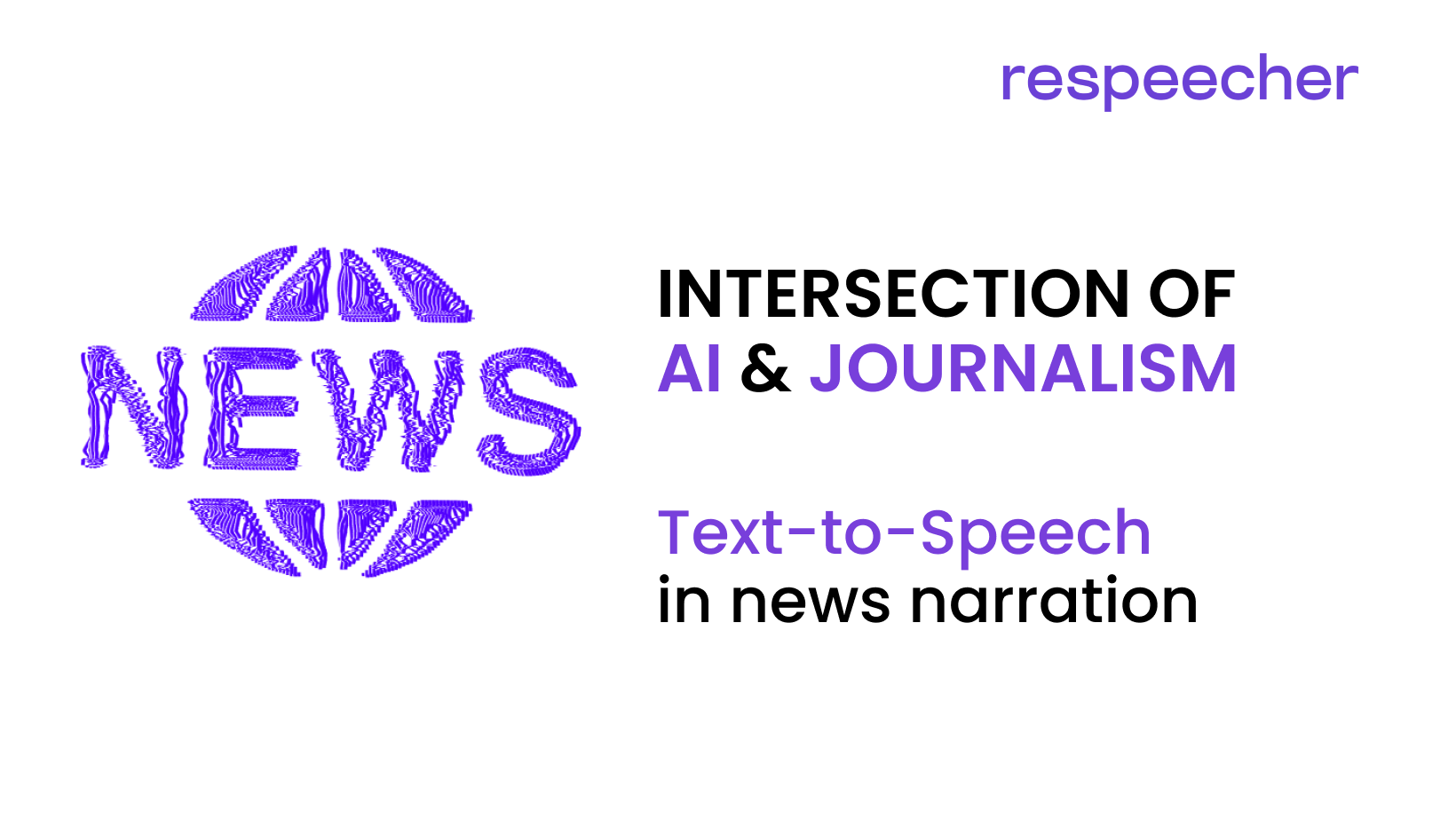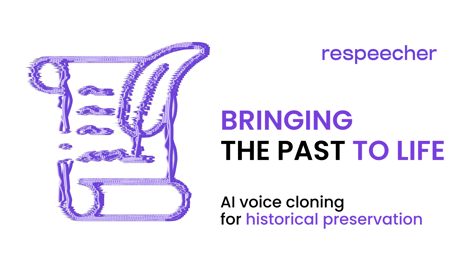The Intersection of AI and Journalism: Text-to-Speech in News Narration

Today, readers expect news to be readily available, easily digestible, and tailored to their preferences. A groundbreaking development that has emerged in response to these evolving demands is the integration of text-to-speech in news narration and media.
The technology of turning text to speech, powered by artificial intelligence (AI), enables the conversion of written text into spoken words with remarkable accuracy and naturalness. This integration represents a significant leap forward in journalism, offering several compelling advantages for news organizations and their audiences.
Overview of Text-to-Speech in Journalism
Text-to-speech (TTS) technology uses artificial intelligence algorithms to convert written text into spoken words. This process involves analyzing the text's linguistic structure, synthesizing natural-sounding speech patterns, and generating audio output closely resembling human speech. In journalism, TTS technology transforms written news articles, blog posts, or digital publications into audio narratives, offering an alternative medium for consuming news content.
The application of AI voice generator technology in journalism has facilitated significant transformations in how news is delivered, accessed, and consumed. By harnessing the power of AI-driven speech synthesis, news outlets can produce audio versions of their articles with remarkable efficiency and accuracy. This not only enhances the accessibility of news content but also extends its reach to a broader audience base.
One primary benefit of using AI voices for news outlets is its ability to increase accessibility for people with visual impairments or reading difficulties. By providing audio versions of news articles, organizations can ensure that their content is inclusive and accessible to all members of society, regardless of their physical or cognitive abilities. This aligns with the principles of diversity and inclusivity that underpin modern digital journalism practices, allowing news outlets to fulfill their mandate of serving the public interest.
Moreover, text-to-speech technology enables audiences to consume news hands-free, offering greater convenience and flexibility in accessing information. With the proliferation of smart speakers, smartphones, and other connected devices, users can listen to news updates while performing other tasks or engaging in activities that require their attention. This seamless integration of audio news into everyday life enhances the user experience and fosters deeper engagement with the content.
Furthermore, TTS technology facilitates the localization and dubbing of news content, enabling news outlets to reach wider audiences across different regions and language demographics. By usig a text to audio converter to generate narratives in multiple languages or dialects, organizations can cater to the linguistic preferences of diverse audience segments and foster greater global engagement with their brand. This enhances news outlets' international presence and promotes cross-cultural understanding and exchange.
Applications of TTS in News Media
Delivery on Various Platforms
Text-to-speech technology is extensively utilized to deliver news across a diverse range of platforms, catering to the preferences and habits of modern audiences. Online news sites leverage AI voice generators to provide audio versions of articles, allowing users to listen to news updates directly on their web browsers. This feature enhances the accessibility and convenience of online news consumption, particularly for users on the go or those with visual impairments.
Mobile apps also integrate TTS functionality to deliver news content to smartphone users. News apps offer the option to listen to articles in audio format, enabling users to stay informed while multitasking or commuting. This hands-free approach to news consumption enhances user experience and encourages greater engagement with the app's content.
Podcasts have also emerged as a popular platform for distributing audio news content, and text to speech technology plays a crucial role in this domain. Podcast producers utilize TTS to narrate news stories, conduct interviews, and present analyses, creating engaging and informative audio programs for their listeners. This flexibility allows news organizations to reach audiences who prefer audio-centric content consumption and capitalize on the growing popularity of podcasting as a medium.
Personalized News Consumption
TTS technology enables personalized news consumption by empowering users to customize their audio experience according to their preferences. One notable application of text-to-speech in this context is the ability to choose the narrator's voice. Users can select from various voices with varying accents, tones, and styles, allowing them to tailor the listening experience to their liking. This feature adds a layer of personalization to news consumption, enhancing user satisfaction and retention.
Furthermore, TTS voice synthesis facilitates the creation of personalized news playlists or channels, where users can curate a selection of articles based on their interests, topics of relevance, or preferred news sources. This curated approach to news consumption ensures that users receive relevant and meaningful content, fostering deeper engagement and loyalty to the platform or service.
Benefits for Media Outlets and Audiences
Expanding Audience Reach
Text-to-speech synthesis plays a pivotal role in expanding the reach of news media outlets by making news content accessible to a broader audience base. Non-native speakers, in particular, benefit from TTS-enabled news delivery as it allows them to overcome language barriers and access news content in their preferred language. News organizations can cater to their audience's linguistic diversity and foster greater global engagement by providing audio versions of articles in multiple languages or dialects.
Furthermore, text-to-speech enhances accessibility for individuals with disabilities, including those with visual or reading impairments. By offering audio versions of news articles, organizations ensure that their content is inclusive and accessible to all members of society, regardless of their physical or cognitive abilities. This commitment to accessibility aligns with ethical principles and strengthens news outlets' reputation and credibility as responsible and socially conscious entities.
Reduction of Production Costs and Time
Text-to-speech technology offers news organizations a cost-effective and efficient solution for producing audio news content. It requires minimal human intervention and can generate audio narratives from written articles in seconds. This significantly reduces production costs for hiring voice talent, recording studios, and post-production editing.
Flexible and Diverse Ways to Consume News
Text to speech synthesis provides audiences with more flexible and diverse ways to consume news, empowering them to choose the format and mode of delivery that best suits their preferences and lifestyles. Whether listening to news updates on their smartphones during commutes, streaming audio articles through smart speakers at home, or tuning into podcasts while exercising, audiences can access news content anytime, anywhere, and on any device.
TTS also enables news organizations to experiment with innovative formats and presentation styles, such as interactive audio experiences, immersive storytelling, and personalized news playlists. This creative freedom enhances user engagement and fosters a deeper connection between audiences and news brands, increasing loyalty, retention, and monetization opportunities.
Case Studies
BBC News
The BBC has been at the forefront of leveraging TTS technology to enhance its news delivery across various platforms. The organization offers audio versions of articles using text-to-speech functionality through its BBC News website and mobile app. This allows users to listen to news updates hands-free, catering to busy individuals who prefer audio content consumption. The BBC's integration of AI in journalism has been well-received by audiences, particularly those with visual impairments or on-the-go lifestyles.
The Washington Post
The Washington Post has embraced generative AI technology to provide audio versions of its articles through its digital platform and mobile app. By integrating text to speech functionality, the newspaper caters to the preferences of users who prefer audio content consumption and enhances accessibility for individuals with disabilities. The Washington Post's adoption of TTS reflects its commitment to innovation and meeting the evolving needs of its audience in the digital age.
Other case studies include Joseph Boon, a New Zealander diagnosed with Friedreich's Ataxia. Respeecher's technology was used to clone his voice. Respeecher also helps patients with speech disabilities recover their voices.
Conclusion
Integrating text-to-speech with tools such as the Respeecher Voice Marketplace in journalism represents a significant milestone in the evolution of AI news narration, delivery, and consumption. As evidenced by the case studies and insights shared, TTS has emerged as a powerful tool for enhancing accessibility, engagement, and flexibility in how news content is consumed. Looking ahead, the implications of text to speech in journalism are profound, with the potential to further democratize news consumption and empower audiences worldwide.

- speech synthesis
- AI voice generator
- generative AI
- Respeecher Voice Marketplace
- text to speech
- text to speech AI
- voice ai
- TTS
- text to audio converter
- text-to-speech technology
- AI in journalism
- speech synthesis technology
- digital journalism
- AI voice in media
- the future of journalism
- text-to-speech in news
- AI news narration





